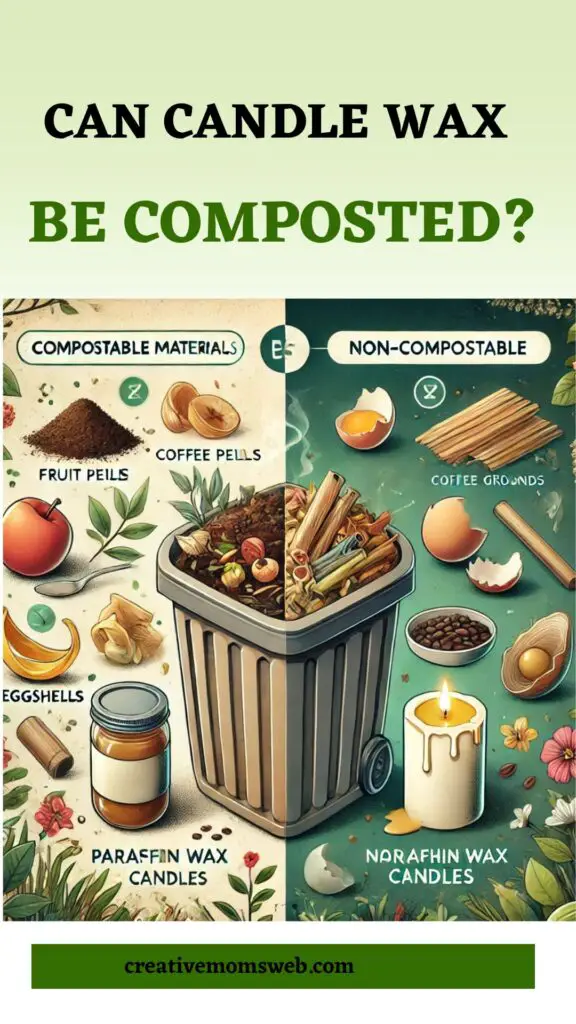Composting has become a popular method for reducing waste and nurturing the earth. But what about candle wax? Can it find a place in the compost pile or worm bin? In this blog post, we’ll explore the question of can candle wax be composted and delve into the considerations and best practices for composting candle wax. Let’s unlock the secrets of turning candle remnants into nutrient-rich soil.

Understanding Composting
Composting is the natural process of recycling organic matter, such as food scraps and yard waste, into nutrient-rich soil. For an item to be compostable, it must break down efficiently and contribute to the compost without introducing harmful substances. If wax can be added to a compost bin and contribute to soil health.
Understanding Candle Wax Composition:
To understand if candle wax can be composted, we need to examine its composition. Candle wax is typically made from different types of materials such as paraffin, soy, or beeswax. Each type has distinct properties that may impact its suitability for composting.
Can You Compost Candle Wax?
1. Natural Waxes
- Soy Wax: Made from soybeans, soy wax is a plant-based material and is compostable. However, ensure that the wax doesn’t contain synthetic dyes or chemical additives, as these could harm the composting process.
- Beeswax: A natural product of bees, beeswax is safe for composting. It breaks down naturally over time and even adds some beneficial properties to the compost.
- Coconut Wax: Derived from coconuts, coconut wax is another compostable option. Like soy wax, ensure it’s free of synthetic additives.
2. Synthetic Waxes
- Paraffin Wax: Made from petroleum, paraffin wax is not compostable. It’s a synthetic material that doesn’t break down naturally and can contaminate compost.
- Blended Waxes: Some candles use a mix of natural and synthetic waxes. These blends may not be fully compostable, so it’s important to check the ingredients.
What About Candle Additives?
Even if the wax is compostable, additives in candles can affect their compostability.
- Fragrances: Natural essential oils are safe for compost, but synthetic fragrances may not decompose and can leach chemicals.
- Dyes: Natural, plant-based dyes are compost-friendly, but synthetic dyes may leave residues.
- Wicks: Cotton and wooden wicks are compostable, but wicks with metal cores or other treatments should be discarded separately.
How to Compost Candle Wax
If you’ve determined your candle wax is compostable, here’s how to do it:
- Clean the Wax: Remove any non-compostable materials like wicks, labels, or metal wick holders.
- Break It Down: Chop the wax into small pieces to speed up decomposition.
- Mix It In: Add the wax to your compost pile, ensuring it’s mixed with other organic materials like kitchen scraps or yard waste to maintain balance.
- Monitor the Compost: Ensure proper aeration and moisture levels to help the wax break down efficiently.
Alternative Uses for Candle Wax
If composting isn’t an option, consider repurposing leftover wax:
- Make New Candles: Melt the leftover wax to create new candles.
- Use as Fire Starters: Mix wax with sawdust or dryer lint to create eco-friendly fire starters.
- Lubricate Sticking Items: Wax can be used to lubricate squeaky hinges or stubborn zippers.
Can Candle Wax Be Composted?
Candle wax can be composted, but it depends on the type of wax. Natural waxes like soy wax, beeswax, and coconut wax are compostable because they are plant-based or derived from natural sources and break down over time. However, synthetic waxes like paraffin, which is petroleum-based, are not compostable as they do not decompose naturally and can contaminate compost. When composting candle wax, it’s essential to ensure it’s free of additives like synthetic fragrances, dyes, or metal-core wicks, which can harm the composting process. For the most eco-friendly option, choose candles made from natural, compostable materials.
Conclusion
Candle wax can be composted if it’s made from natural, plant-based materials like soy, beeswax, or coconut wax. Synthetic waxes, such as paraffin, should not be added to compost due to their petroleum-based composition. For a more sustainable approach, choose natural wax candles and consider repurposing wax remnants.
What do you do with leftover candle wax? Share your tips in the comments below!
Want more eco-friendly living tips? Explore our blog for practical ideas to reduce waste and live sustainably.

Shop My Favorite Essentials for Candle Making: A Complete Guide for Stay-at-Home Moms
Candle making is a fantastic hobby that allows stay-at-home moms to tap into their creativity, relax, and even start a small business. Whether you’re a beginner or looking to refine your skills, having the right tools and materials is essential. Here’s a list of must-have candle making supplies available on Amazon to get you started. Each item includes a specific product example to make your shopping easier.
1. Wax
Wax is the foundation of any candle. Different types of waxes like soy, beeswax, and paraffin have their unique benefits.
Recommended Product:
- NatureWax C-3 Soy Wax
NatureWax C-3 Soy Wax on Amazon
This all-natural soy wax is perfect for beginners. It provides a smooth finish and excellent scent throw, ideal for container candles.
2. Wicks
Choosing the right wick is crucial for an even burn. Cotton wicks are the most popular, but wood wicks can add a unique crackling sound.
Recommended Product:
- EricX Light 100 Piece Cotton Candle Wicks
EricX Light Candle Wicks on Amazon
These eco-friendly cotton wicks are pre-waxed and come in various sizes, making them perfect for different candle types.
3. Fragrance Oils
To add delightful scents to your candles, fragrance oils are a must. Make sure they are specifically formulated for candle making.
Recommended Product:
- P&J Trading Fragrance Oil Set
P&J Trading Fragrance Oil Set
This set includes a variety of scents like lavender, vanilla, and sandalwood. The oils are highly concentrated, ensuring a long-lasting fragrance.
4. Dye for Candle Coloring
If you want to add color to your candles, go for candle-specific dyes that won’t clog your wick.
Recommended Product:
- Candle Shop Candle Dye Flakes
Candle Dye Flakes
These dye flakes come in a variety of colors and are easy to use. Just a small amount can give you vibrant colors without affecting the candle’s performance.
5. Candle Molds
For creative shapes beyond standard jars, silicone molds are a versatile option.
Recommended Product:
- Cozyours Silicone Candle Molds
Cozyours Silicone Molds
These reusable molds come in various shapes like hearts and stars, perfect for making unique candles.
6. Candle Pouring Pot
A pouring pot is essential for safely melting and pouring your wax. It allows for easy control to prevent spills.
Recommended Product:
- CandleScience Aluminum Pouring Pot
CandleScience Pouring Pot
With a 2-pound capacity, this pouring pot is lightweight, durable, and perfect for handling hot wax.
7. Thermometer
Temperature is key in candle making. A thermometer ensures your wax is at the optimal temperature for adding fragrance and pouring.
Recommended Product:
- KT THERMO Deep Fry Thermometer with Clip
KT THERMO Deep Fry Thermometer
This stainless steel thermometer comes with a clip, making it easy to attach to your melting pot. It provides accurate readings between 50°F and 550°F, perfect for monitoring wax temperature. The large dial display ensures you can easily read the temperature, and the clip keeps it secure during the melting process.
Key Features:
- Temperature Range: 50°F to 550°F (10°C to 290°C)
- Clip Attachment: Securely clips onto the side of your pot for hands-free monitoring
- Large, Easy-to-Read Dial: Clear display for quick temperature checks
- Durable Stainless Steel Construction: Built to last and easy to clean
This thermometer is versatile and can also be used for cooking, making it a handy tool to have in your kitchen.
8. Heat Gun
A heat gun helps smooth out the tops of candles and fix imperfections like sinkholes.
Recommended Product:
- Chandler Tool Heat Gun
Chandler Tool Heat Gun
This compact heat gun is perfect for candle makers. It features two heat settings and a built-in stand.
9. Candle Labels
For a professional finish, especially if you’re selling your candles, consider using pre-made labels or printable sticker sheets.
Recommended Product:
- Avery Printable Round Labels
Avery Round Labels
These glossy labels are easy to customize and print, giving your candles a professional touch.
10. Candle Containers
Containers like tins, jars, and votives are essential for making container candles.
Recommended Product:
- Accguan 12 Pack Glass Candle Jars with Bamboo Lids
Accguan Glass Candle Jars
These elegant glass jars come with airtight bamboo lids, perfect for preserving the scent of your candles. They have a modern and minimalist design, making them ideal for creating gifts or selling candles. Each jar holds about 7 oz, which is perfect for medium-sized candles.
Key Features:
- Quantity: 12 jars per pack
- Capacity: 7 oz per jar
- Material: High-quality, heat-resistant glass with bamboo lids
- Design: Clear glass for a sleek look, ideal for showcasing candle colors
- Versatile Use: Great for candle making, storage, or home decor
- YIHANG 24 Pack Candle Tins
YIHANG Candle Tins
These tins come with lids and are perfect for travel candles or gift sets. They are durable and reusable.
11. Wick Centering Device
To ensure your wick stays perfectly centered as your candle sets, a centering device is a handy tool.
Recommended Product:
- DINGPAI Adjustable Candle Wick Holders (12-Pack)
DINGPAI Adjustable Wick Holders
These adjustable wick holders are designed to fit various container sizes, making them a versatile choice for candle making. Made from durable stainless steel, they can be adjusted to perfectly center your wick in jars, tins, and other containers. The adjustable arms allow you to secure multiple wick types, whether you’re using cotton or wooden wicks.
Key Features:
- Quantity: 12 holders per pack
- Material: High-quality stainless steel, built to last
- Adjustable Design: Expandable arms to fit containers from 2 inches to 4 inches wide
- Versatility: Suitable for single or double wicks, as well as wood wicks
- Ease of Use: Keeps wicks perfectly centered for an even burn
12. Safety Equipment
Safety should always come first. Protect yourself with gloves, aprons, and safety glasses when working with hot wax.
Recommended Product:
- NoCry Cut Resistant Gloves
NoCry Gloves
These gloves are heat-resistant and protect your hands from hot wax spills and burns.
